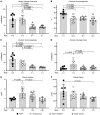Free fatty acid processing diverges in human pathologic insulin resistance conditions
- PMID: 32191645
- PMCID: PMC7324196
- DOI: 10.1172/JCI135431
Free fatty acid processing diverges in human pathologic insulin resistance conditions
Abstract
BACKGROUNDPostreceptor insulin resistance (IR) is associated with hyperglycemia and hepatic steatosis. However, receptor-level IR (e.g., insulin receptor pathogenic variants, INSR) causes hyperglycemia without steatosis. We examined 4 pathologic conditions of IR in humans to examine pathways controlling lipid metabolism and gluconeogenesis.METHODSCross-sectional study of severe receptor IR (INSR, n = 7) versus postreceptor IR that was severe (lipodystrophy, n = 14), moderate (type 2 diabetes, n = 9), or mild (obesity, n = 8). Lipolysis (glycerol turnover), hepatic glucose production (HGP), gluconeogenesis (deuterium incorporation from body water into glucose), hepatic triglyceride (magnetic resonance spectroscopy), and hepatic fat oxidation (plasma β-hydroxybutyrate) were measured.RESULTSLipolysis was 2- to 3-fold higher in INSR versus all other groups, and HGP was 2-fold higher in INSR and lipodystrophy versus type 2 diabetes and obesity (P < 0.001), suggesting severe adipose and hepatic IR. INSR subjects had a higher contribution of gluconeogenesis to HGP, approximately 77%, versus 52% to 59% in other groups (P = 0.0001). Despite high lipolysis, INSR subjects had low hepatic triglycerides (0.5% [interquartile range 0.1%-0.5%]), in contrast to lipodystrophy (10.6% [interquartile range 2.8%-17.1%], P < 0.0001). β-hydroxybutyrate was 2- to 7-fold higher in INSR versus all other groups (P < 0.0001), consistent with higher hepatic fat oxidation.CONCLUSIONThese data support a key pathogenic role of adipose tissue IR to increase glycerol and FFA availability to the liver in both receptor and postreceptor IR. However, the fate of FFA diverges in these populations. In receptor-level IR, FFA oxidation drives gluconeogenesis rather than being reesterified to triglyceride. In contrast, in postreceptor IR, FFA contributes to both gluconeogenesis and hepatic steatosis.TRIAL REGISTRATIONClinicalTrials.gov NCT01778556, NCT00001987, and NCT02457897.FUNDINGNational Institute of Diabetes and Digestive and Kidney Diseases, US Department of Agriculture/Agricultural Research Service 58-3092-5-001.
Keywords: Adipose tissue; Endocrinology; Glucose metabolism; Insulin.
Conflict of interest statement
Figures




References
Publication types
MeSH terms
Substances
Associated data
LinkOut - more resources
Full Text Sources
Medical
Miscellaneous

